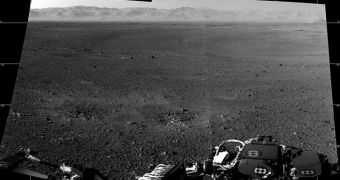Experts at the American space agency fear that the Mars Science Laboratory (MSL) rover Curiosity may contaminate the Red Planet with living bacteria from Earth. An error that occurred while the robot was assembled may lead to this outcome.
The mistake may have taken place around 6 months before Curiosity's November 2011 launch, when an engineer at NASA opened a sealed container to install a component without notifying colleagues in charge of decontamination.
He did so in order to install a new drill bit in a box meant to be used by the drilling mechanism on Curiosity's robotic arm. The expert feared that the landing may be so rough as to damage that original drill bit, so he installed a backup one.
However, the sealed container that held the former had already been sealed, decontaminated, and set aside for integration with the rest of the flight hardware. The engineer opened it, installed a new drill bit, closed it back up and went about his day.
According to microbiologists, in excess of 250,000 bacterial spores may have made their way into the sealed container as a result. These microorganisms are very sturdy, and can withstand a trip to Mars without being eradicated, Wired reports.
Therefore, if Curiosity drills into the Martian soil and finds water, the Red Planet would have been seeded with alien life. This would equate to NASA cutting the branch from under its own feet, since all positive results in the quest for former Martian life would be plagued by a huge uncertainty.
The people who opened the sealed box say that it was a calculated risk, since Gale Crater – where Curiosity landed – was chosen precisely because it is very dry. The likelihood of finding water here is remote, to say the least.
NASA scientists are now keeping their fingers crossed about Martian puddles or water reservoirs. Coming across such features would mean that the drill on the rover's robotic arm would remain non-operational, perhaps for the entire duration of the mission.
This would be a real shame, considering the amount of work and resources invested in designing it and getting it to Mars, and the potentially-huge scientific return we may get from using it on the Red Planet.

 14 DAY TRIAL //
14 DAY TRIAL //